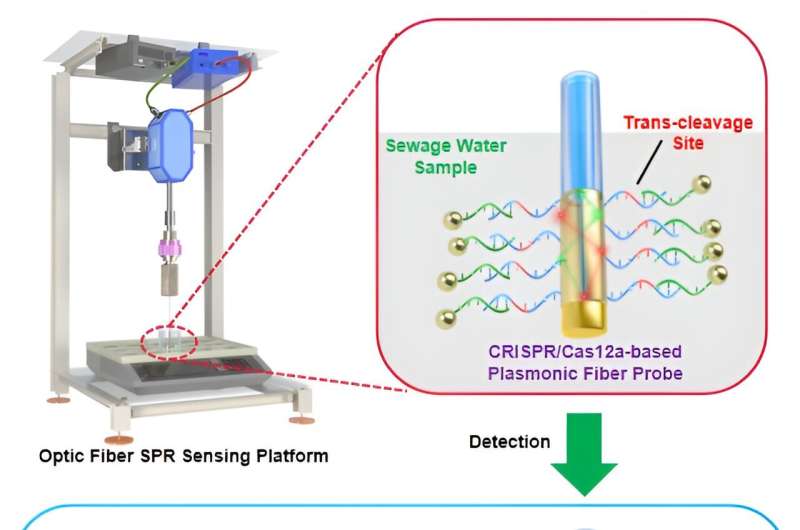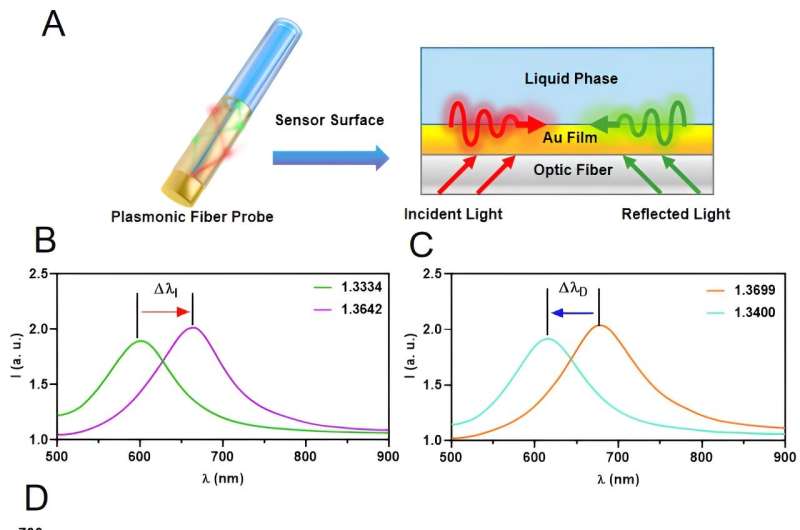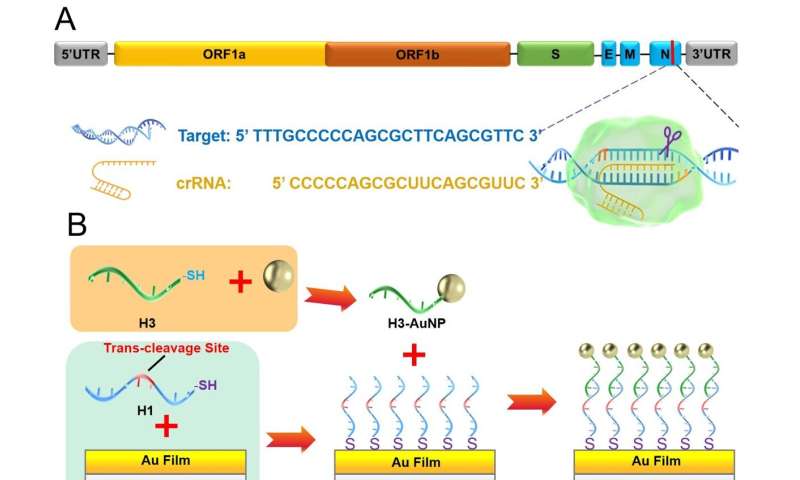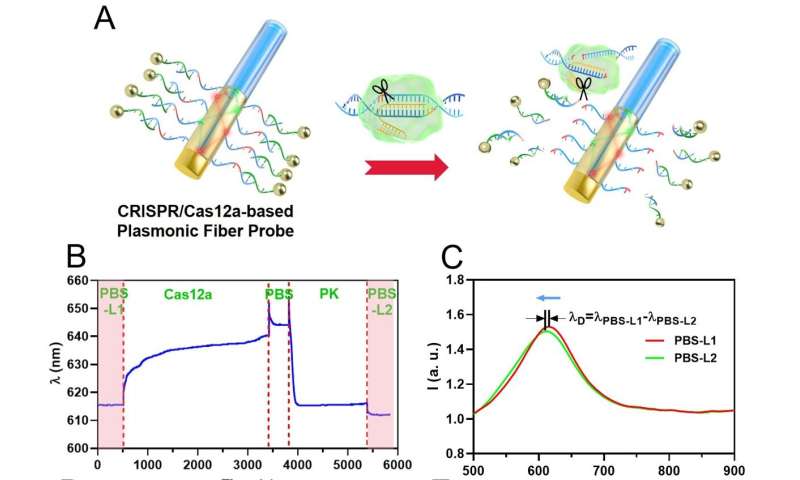This article has been reviewed according to Science X's editorial process and policies. Editors have highlighted the following attributes while ensuring the content's credibility:
fact-checked
peer-reviewed publication
proofread
Surveillance and genotyping of SARS-CoV-2 in sewage water by Cas12a-facilitated portable plasmonic biosensor

Infectious diseases severely threaten public health and global biosafety. In addition to transmission through the air, pathogenic microorganisms have also been detected in environmental liquid samples, such as sewage water. The various methodologies utilized in the clinical diagnosis of pathogens are often time-consuming and cost-ineffective, and their detection limits are not satisfactory for processing environmental samples, which contain only scant amounts of microorganismal DNA/RNA.
To address these difficulties, a recent study led by Prof. Han Zhang from Shenzhen University demonstrates the first application of fiber surface plasmon resonance (SPR) technology in the sensing of SARS-CoV-2 virus in environmental samples. This work has been just published in Research, introducing a novel SPR-based point of care testing (POCT) strategy for pathogenic microorganisms in water samples.
In the current study, the authors manufactured an ultrafine plasmonic fiber probe with a diameter of 125 µm. To ensure the specificity of the plasmonic biosensor, the viral genomes are automatically enriched and the nucleocapsid (N) gene is amplified before its reaction with the clustered regularly interspaced short palindromic repeats (CRISPR) protein Cas12a.

Once the N gene is recognized, Cas12a trans-cleaves single-stranded DNA exposed on the fiber surface and releases gold nanoparticles (AuNPs) that have been previously immobilized, causing a sharp reduction in the characteristic SPR wavelength. Hence, the fiber SPR apparatus converts biological information generated by the CRISPR enzyme into SPR signals that are further amplified by the release of AuNPs.
The proposed fiber probe is virus-specific with the limit of detection of ~2,300 copies/mL, and copy numbers of viral genome can be reflected as shifts in wavelengths. A series of sewage water samples from different sources have been examined by fiber SPR, and the data obtained from the biosensor are consistent with those of quantitative polymerase chain reaction (qPCR) and colorimetric assays. The omicron variant and its mutation site (L981F) have been fast-detected using S-gene-specific Cas12a, suggesting the successful detection of single nucleotide mutations.
Although the end of COVID-19 pandemic has been announced by WHO, the surveillance and prevention of pathogen spread are still urgently required for the ongoing maintenance of biosafety worldwide.
-

Fabrication of plasmonic fiber probe. (A) Schematic view of fiber probe fabrication procedure. (B) Changes of SPR signals shown as wavelength during fabrication. (C) Comparison of spectra recorded at beginning and end of fabrication process. Δλ I indicates the change of SPR signals at final (λ PBS-L3 ) and initial (λ PBS-L1 ) PBS equilibration stages. Credit: Research (2023). DOI: 10.34133/research.0205 -

Fiber optic sensing of viral N gene DNA. (A) Graphical view of Cas12a- mediated cutting of ssDNA immobilized on fiber surface. (B) A typical sensorgram showing Cas12a-mediated DNA sensing and following wash-off by Proteinase K (PK). DNA concentration: 60 pg/µL. (C) Spectra shift indicating SPR signals due to Cas12a-mediatedrelease of AuNP. Δλ D reflected the wavelength change between PBS-L1 and PBS-L2 stages. (D) Examples of SPR wavelength changes at different DNA concentration. (E) Comparison of SPR signals acquired with sensors after different storage periods. Data were shown as mean +/- s.e.m. (n=3). Credit: Research (2023). DOI: 10.34133/research.0205
With simple substitutions of crRNAs, this device can be employed to sense various microorganisms in environmental samples and to perform accurate genotyping based on DNA sequence recognition by the CRISPR enzyme. Thanks to its ease of assembly and minimized space occupancy, the plasmonic fiber sensor can be set up adjacent to drainage outlets for in situ tracking the transmission of pathogens.
This work provides an accurate and convenient approach for the real-time monitoring of microbial contamination in sewage water.
More information: Tianzhong Li et al, Early and Sensitive Detection of Pathogens for Public Health and Biosafety: An Example of Surveillance and Genotyping of SARS-CoV-2 in Sewage Water by Cas12a-Facilitated Portable Plasmonic Biosensor, Research (2023). DOI: 10.34133/research.0205
Journal information: Research
Provided by Research




















